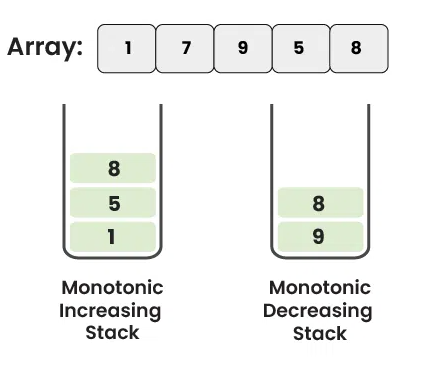Monotonic Stack
Definition
Monotonic Stack maintaining elemenst in either increasing or decreasing order. It is commonly used to efficiency solve problems such as finding the next greater or smaller element in an array etc.

Types of Monotonic Stack
Monotonic Stacks can be broadly classified into two types:
- Monotonic Increasing Stack
- Monotonic Decreasing Stack
Monotonic Increasing Stack
A Monotonically Increasing Stack is a stack where elements are placed in increasing order from the bottom to the top. Each new element added to the stack is greater than or equal to the one below it. If a new element is smaller, we remove elements from the top of the stack until we find one that is smaller or equal to the new element, or until the stack is empty. This ensures that the stack always stays in increasing order.
To achieve a monotonic increasing stack, you can follow these step-by-step approaches:
1 | |
Monotonic Decreasing Stack
A Monotonically Decreasing Stack is a stack where elements are placed in decreasing order from the bottom to the top. Each new element added to the stack must be smaller than or equal to the one below it. If a new element is greater than top of stack then we remove elements from the top of the stack until we find one that is greater or equal to the new element, or until the stack is empty. This ensures that the stack always stays in decreasing order.
To achieve a monotonic decreasing stack, you can follow these step-by-step approaches:
1 | |
Costs
| Worst Case | |
|---|---|
| space | \(O(n)\) |
| time | \(O(n)\) |
Suitable situation
Tips如果要找"更X的元素",就用与X相反的单调性质的栈
- Finding the next greater element: Monotonic Decreasing Stack
- Finding the next smaller element: Monotonic Increasing Stack
- ...
Strength & Weaknesses
Strength:
- Efficient for finding the next greater or smaller element in an array.
- Useful for solving a variety of problems, such as finding the nearest smaller element or calculating the maximum area of histograms.
- In many cases, the time complexity of algorithms using monotonic stacks is linear, making them efficient for processing large datasets.
Weaknesses:
- Requires extra space to store the stack.
- May not be intuitive for beginners to understand and implement.